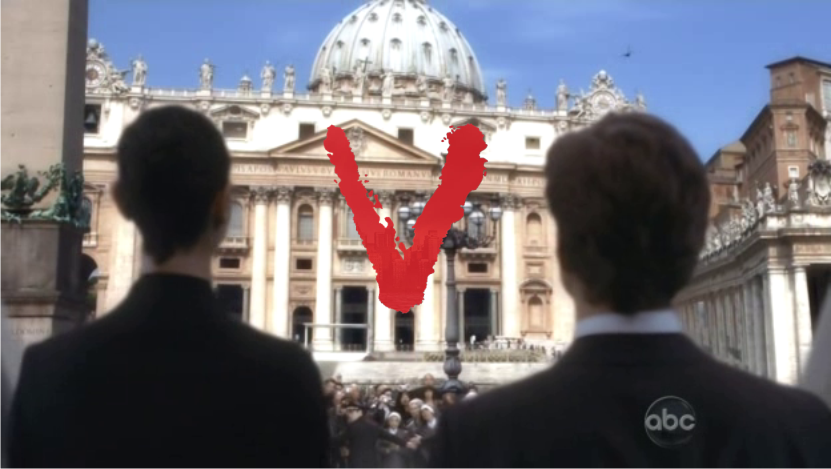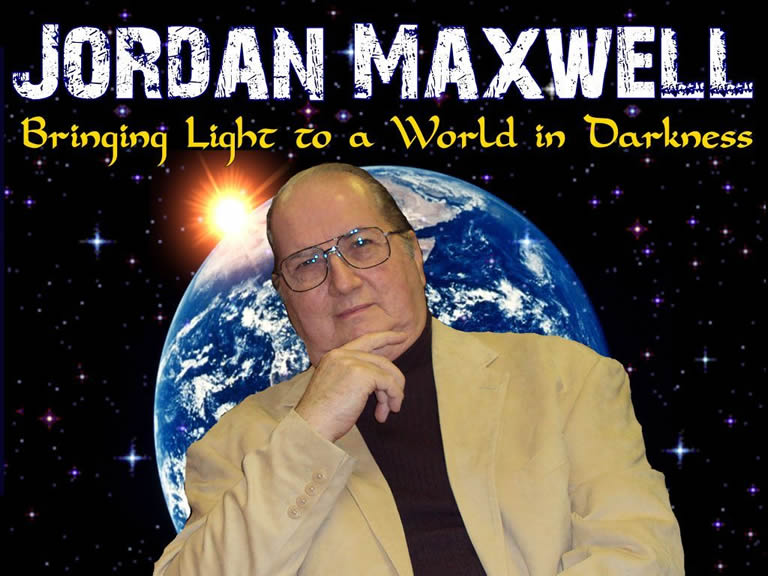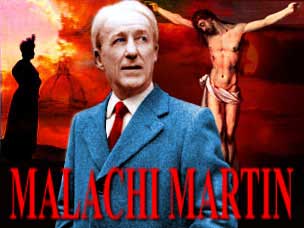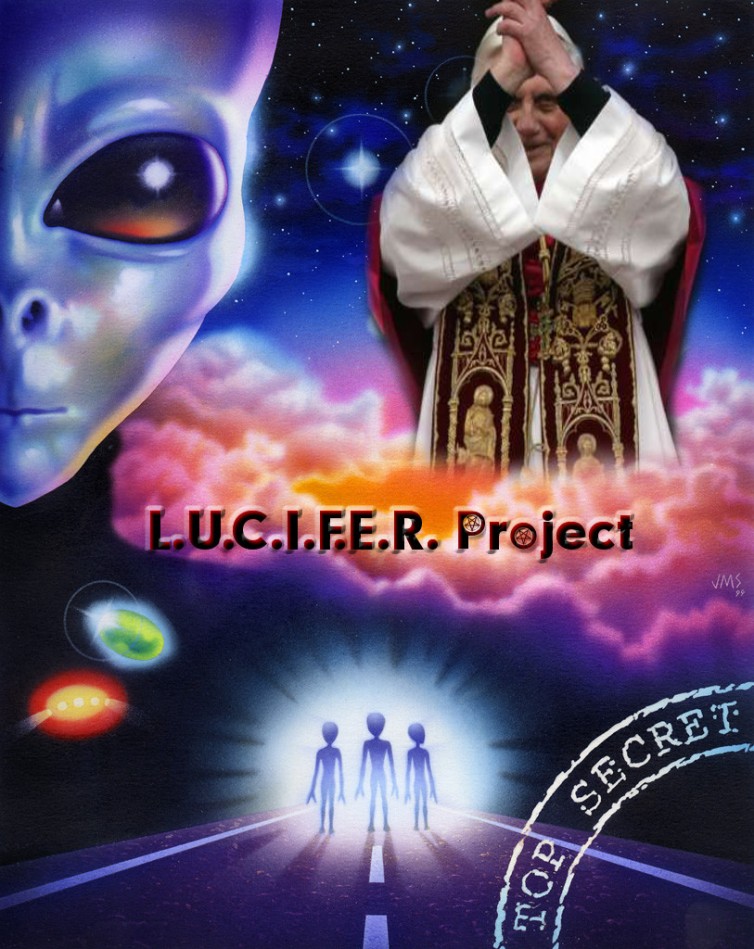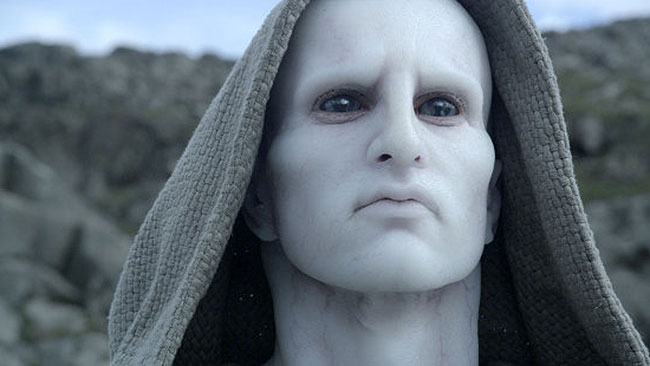I continue to get the sinking feeling that we are on the verge of a nasty Solar System Star War -- World War III -- the Battle of Armageddon -- the Apocalypse -- the Seven Last Plagues -- the Extermination of the Human Race -- etc, etc, etc. I sense that there is a Solar System Cold War which very few people know anything about. I'm fighting internal battles which most people have no idea about. I think that if we survive the next couple of decades, that technology might make most human labor obsolete -- to the point where we might wish we had been exterminated. Perhaps that's too severe -- but I'm not sure that the technology of the next couple of decades will save humanity. It might do just the opposite. Something really, really bad happened in antiquity -- and I don't know what it was. They keep me guessing. They keep all of us guessing. I keep wondering about the possibility of Michael being overthrown by Gabriel and Lucifer -- with Michael and Humanity becoming essentially Hostages to the Devil (from our perspective). Yet, from the other hypothetical side's perspective Gabriel and Lucifer might be doing God's Work -- to reign-in and re-train a Rebellious Race living on a Prison Planet in Rebellion. Once again, there are probably very, very few people who will take the time and trouble to REALLY think through these sorts of questions and issues. They take a helluva lot of time, pain, strain, and conflict to properly examine and reflect-upon. I'm sorry if I got the Gabriel and Lucifer parts of this puzzle wrong. I truly mean no harm -- yet there seems to be a helluva lot of deception and manipulation going on in this world. Something seems to be very wrong. Something seems to have been very wrong for a very long time. On the other hand -- if humanity does not want me and what I might have to offer -- I'll leave -- never to return -- even if there's no place to go. What if the original plan for this planet and humanity got implemented somewhere else -- after being rejected here?? What if the PK-47s or Future Humans are from these hypothetical places?? Was the original plan the best plan?? Is it still the best plan?? If so, who should implement it?? What Would Magoo Do??
Mr. Magoo Meets Frankenstein! https://www.youtube.com/watch?v=V41EIFxJ37s
Mr. Magoo and Noah's Ark 1. https://www.youtube.com/watch?v=FxhR412hvVY 2. https://www.youtube.com/watch?v=6ww2KSHjboE 3. https://www.youtube.com/watch?v=e24l-Oa-OnI


OK...a lot of people hate me. I have been blocked by several YouTube channels - including the poster of the video series upon which this thread is mostly based. ufohypothesis (Rick Keefe - who interviews Alex Collier) has blocked me. Another one - which is critical of the Roman Catholic Church - has blocked me. This is very, very odd - since I am mostly editorially on-board with the blockers!!! None of them told me a damn thing - so I have no idea why I have been blocked. Two of my websites have been taken over by someone I have never heard of - and one has been removed from the internet - even though I am paid-up for several years. I am very paranoid - and they probably really are out to get me. Strange world we live in.
What's odd - is that I really and truly have no animosity toward anyone. Period. Although - to be honest - I am annoyed by just about everyone - especially myself. But I have no seething agenda or fecal list. I really and truly am seeking a big-tent solution - rather than something which is narrow and exclusive. It's an equal-opportunity big-tent for males, females, hermaphrodites, and all races - including aliens and hybrids! I think I'm probably way too accomodating and easy-going.
I'll watch videos about NDE, OBE, and Regression -- but I won't seek this sort of thing. It's just the way I was brought up. I think I'm playing a dangerous-enough game as it is. Thus far -- and no farther.
I get the impression that most of those who constitute the Top One-Percent belong to some sort of a Secret Club (which might have several names -- but one ultimate boss -- who might not be on the side of humanity -- for whatever reasons). Sometimes I wonder about the true source of a lot of French Romantic Music. Does this music have something in common with William Shakespeare, Charles Darwin, and Albert Einstein? Who was the architect of Chartres Cathedral? Does anyone have any idea of what I am talking about? Anyone?
I'm not going to be too specific - but if one looks at French Romantic Organ Music as a whole - what personality lurks within the music? Is it the Creator God of the Universe? Is it Jesus Christ? Is it Lucifer? Is it Mary? The individual composers? The complexity and abstractness is overwhelming. The level of genius in the design and construction of pyramids, temples, and cathedrals is likewise overwhelming. Yet something dark and troubled seems to lurk within. Could this be representative of the 'good-side' of Kali? If I'm right about all of this - do I at least get a Cracker-Jack Prize?
I guess I'm passively pursuing a 'Pinky and the Brain - Raiders of the Lost Ark - Lucifer/Shiva/Kali/Mary - and the Temple of Doom' Hypothesis - which includes a good/genius side - and a bad/insane side. What did Spielberg know - and when did he know it? I find myself strangely attracted to the good side - and utterly disgusted and horrified by the bad side. I tend to think that if Lucifer/Shiva/Kali/Mary retired - that the bad side would go away - and that they could serve as an advisor rather than a dictator. You'd have to actually be me to understand where I'm coming from, and to see that which I visualize. I couldn't possibly put it into words.
I just finished reading 'The Gospel of Mary of Magdala' by Karen King. The cover features a painting of a young-woman with a very dark complexion - dressed in scarlet - with a sun-disk around her head - pointing to an egg in her hand. Could this be Kali? Karen King thinks the Gospel of Mary might have been written in Egypt or Syria, with an authorship date of between 32 and 325 CE. Could Kali be the writer of most sacred texts - including the Bible and the Quran? Ralph Ellis claims that Jesus Christ and Mary Magdalene were of a high class. Nicolas Notovich claims that Jesus travelled to Tibet. Alex Collier claims that our creator (or genetic engineer) is more female than male (not sure which lecture - possibly 2002). He also claims that the Andromedans consider blacks to be genetically superior (I hope I got that one right! Not sure which lecture). In a 2002 lecture - Alex hints at a deliberate removal of the Pa Taal (spelling?).
I think I'm going to give this thing a rest. I don't really wish to convince anyone of anything. This has mostly been a research project - in a very passive and informal sense. The Jesuits, Alphabet Agents, and World Leaders know exactly what's going on - and they obviously are not stumbling over each other to get to the microphone first - to tell all of us goyim the truth, the whole truth, and nothing but the truth. In a sense - I have mostly wished to communicate with Lucifer/Shiva/Kali/Mary and his/her willing and unwilling servants. I continue to desire a top-down reformation of how business is conducted in this solar system. Hope springs eternal - but I'm not holding my breath. Namaste.
Try thinking through the history of Earth from a Hathorian Perspective (HP) or a Kali Perspective (KP)...based upon this thread combined with your own extrapolation and imagination. Should this hypothetical Hathor or Kali figure be an object of aspiration rather than veneration?
I don't know if I have had a close encounter with truth...or not. I invite everyone to go through all of my threads with a fine-tooth comb. See what your conclusions are. I've simply been scratching the surface of the truth...on a road less traveled. But that could make all the difference...on your investigative journey. Amen.
Is there anyone in the solar system who openly thinks like I do? I like to think - and I hate to think. It usually hurts when I think. Efforts to figure things out, solve problems, and save the world - seem to go largely unrewarded, and are often punished. Perhaps it really is better to give people what they want - and tell them that which they wish to hear. I often think that I might hit it off better with Lucifer/Shiva/Kali/Mary/Anna (if they really do exist - as I have speculated) than with just about anyone else - even though we would probably fight like hungry feral cats. At least there might be somewhat of a common understanding of things - even though our conclusions and courses of action would probably be diametrically opposed. I continue to desire some sort of an interaction with whoever is really and truly at the top of the pyramid - without mind-games or mumbo-jumbo. Just the facts ma'am. But just tending to business is looking more and more attractive. Thinking the unthinkable - and trying to know the unknowable - has taken it's toll. Then - trying to communicate with others about these things has been sort of like trying to reinvent the wheel.
Positive thinking is a double-edged sword which can lift one higher - or be a deluded detour down the primrose path. I am simply trying to face reality - in a very unconventional sense. I think I've found a lot of my answers - and I don't necessarily like them. The search has been somewhat destabilizing - and I fear what may happen to the general public when they really start getting exposed to a lot of what I have uncovered - assuming that at least some of it is true.
BROOK has supplied SO MUCH valuable information on AV1 and MOA. A thread titled 'Amen Ra' on AV1 contains a lot of BROOK's hard work and research. http://projectavalon.net/forum/showthread.php?t=18223 Even though AV1 is closed to posting - the view count on this thread seems to rise by about 1,000 per month. That thread on the 'Infiltration of the New Age Movement' which starninja has contributed so much to - is a must view for all truth seekers and curiosity seekers. What you don't know - can hurt you.
Balance is an important part of all of this - and I have been losing my balance - little by little - which is why I'm really trying to stop - at least for a while. Bill Cooper had alcohol and temper issues - and I think it may have had a lot to do with all of the upsetting information he was dealing with. I really think that the Powers That Be have made the decision to inform the public about what's really been going on - in a gradual and unofficial manner. How responsibly we deal with this information - will determine how quickly and smoothly disclosure occurs. Take a closer look at China, India, Tibet, and Kali. Just a hunch...
I've been wondering a lot about the true nature of the soul - and wondering about the true extent of any hybridization programs - historically and presently. What if the human soul is a shapeshifting interdimensional reptilian? Could this be why we have a reptilian part of our brains? Could this really be the biggest secret? Are all of us hybrids - in one way or another? Are Dracs really human/reptile hybrids - with an exceptionally high percentage of reptile genetics? Are everyday humans really human/reptile hybrids - with a very low percentage of reptile genetics? I once knew an ivy league graduate who told me that they were a talking snake. Some of my best friends have turned out to be snakes.
It seems reasonable to me to at least begin with the view that this solar system is our home (regardless of ancient star wars and battles for control of this and that) - and that we just keep reincarnating (as we require new bodies) back into this solar system - and that this solar system may be as good as it gets - anywhere. I'm considering any extermination events (natural or inflicted) and mass evacuations (by UFO's, the Second Coming of Christ, etc.) to be bad things. Bringing reason and peace to this solar system seems reasonable to me. Has the Queen of Heaven been trying to do this for thousands of years? OR - has the Queen of Heaven been misusing and abusing this solar system and it's inhabitants for thousands of years? I keep seeing corruption and insanity as being unavoidably connected with absolute power - despite the best of intentions - which is why I wish for this hypothetical Queen of Heaven to retire - and serve as an advisor rather than a ruler. Sorry for being repetitious - but I will continue to test this hypothesis in different settings. I think we are all in Purgatory - and that it is up to us whether we progress into Heaven - or digress into Hell. We make our bed - and sleep in it. Our planet is how we plan it. World without end.
"Semiramis became known as the "queen of heaven," and was the prototype from which all other pagan goddesses came."--World Religions by David Terrell
George Kavassilas said that Jesus had to be annointed by Mary Magdalene - and get permission from her - to be able to do his work. He also said that Mary Magdalene was an incarnation of the Divine Mother. He further said that in cathedrals - one must go through the mother to get to the Christ energy. Finally, he said that the rock who Jesus intended to build his church upon - was Mary Magdalene.
I have speculated that the Queen of Heaven aka Whore of Babylon aka Mary Magdalene aka Woman in Scarlet - created the Historical Jesus - to be a Red Herring. Having said that - I continue to reverence the Teachings of Jesus - even if my blasphemous speculations are true. All of this probably has a 5% chance of being true - but I will continue to climb further and further out on a very thin limb. Did the Woman in Scarlet write the Red Letters? I'd better stop.
George warns of ET's who claim to be here to help - and speak of love - as being deceptive enemies. Could these be some of the ET's who Alex Collier says we need to be mentored by? I am very skeptical regarding mentoring. Early Collier interviews stated that all the ET's should leave - and just leave us alone - and stop interfering with us, and stop manipulating us. Which ET's are promoting Responsibility and Human Sovereignty? Have any of them done so over the past several thousand years? Does the Bible do so? Why is Responsibility and the U.S. Constitution not the preferred foundation for this solar system? I keep sensing that Steven Greer and even Alex Collier are being strong-armed by ET's to promote their agenda. I sense that a lot of people are joining them - because they feel that we cannot beat them. I can't prove this - but I feel very ill regarding all of this.
Starninja to Orthodoxymoron: I couldn’t say it better. Why would we want to be mentored?
 Not good enough for me. Secondly, TPTB worked hard for ages to convince us that we powerless and insecure. Well, they can’t control people who are secure within themselves. I see it as a big problem for those who don’t trust themselves, eager to give up responsibility and personal power away.
Not good enough for me. Secondly, TPTB worked hard for ages to convince us that we powerless and insecure. Well, they can’t control people who are secure within themselves. I see it as a big problem for those who don’t trust themselves, eager to give up responsibility and personal power away. Reply: Thank-you starninja. I don't wish to slam Alex Collier, Steven Greer, or the ET's (Human/Reptile Hybrids?). I just wish to work toward a minimalist solar system government - which avoids the absurdities and atrocities of the past. The human race obviously has HUGE ethical and psychological problems which need to be remedied - but if the Secret Government, the United Nations, the Vatican, the City of London, Washington D.C., the Alphabet Agencies Worldwide, the Underground Bases, the Secret Space Program, the Secret Societies, and the Royal Family, et al - were truly governed by Responsibility and the U.S. Constitution - with 10,000 representatives from throughout the solar system - I have a feeling that things would improve - after a rough and rocky transition period. I tend to think that all of us are products and victims of our circumstances - and I have absolutely no animosity or ill-will toward any of the organizations or individuals mentioned above. I'm just trying to visualize what the best next step should be. I suspect really, really nasty ancient wars in this solar system (and elsewhere) - which may not be resolved - even at this late date. If reincarnation is a reality - we may have all been a part of unspeakable horrors. I don't know the whole story. I probably don't even know 1% of the whole story - so all of my presuppositions, speculations, and proposed solutions - might be complete BS. But somehow, We the Goyim - must begin to attempt to think everything though - and not just leave it up to the ET's and the Secret Societies.
Thank-you Carol. I always feel humbled when I read your posts. You have obviously done a huge amount of research - you are an experiencer - and you know key people personally. I'm just an armchair blogger - and I am propelled forward (backward?) by my insecurities.Carol wrote:I personally know Alex Collier and much about him. He has not had contact for years although he would like to have contact and puts up a false front about having recent contact. And one of the things I've personally heard him say repeatedly is that humans are right up there with everyone else (maybe not technologically and maybe some alien races are more spiritually evolved but we should never become slaves to anyone.}
His experience was real yet his life a bit of a mess. Collier isn't being strong armed by anyone. As for Greer, he is his own man with his own agenda and is involved with ET contact via group meditation. I've read these men's unpublished and published interviews and they are close to Paola Harris who is a close personal friend of mine.
It would be liberating if the general public had some type of concrete clue as to how many types of ETs the US government have treaties with. There are 114 different alien races that we know about and in my personal opinion, the US military FIRST chose to go with the ones who were at the bottom of the barrel (greys, reptilians and demons). Heaven help us.
I like Alex Collier a lot - and I listen to him more than just about anyone else. But I sense a lot of internal conflict. I also sense that he knows a lot more than he reveals publicly. He probably gets into a huge amount of trouble for what he does reveal. Strong arming can occur in a lot of different ways. Perhaps that was too strong of a term. I just detect a sense of resignation in people like Jordan Maxwell, Steven Greer, and Alex Collier. Jordan has been open about this. Steven stated at a 2005 X-Con (I think) that the ET agenda was going to be implemented whether the governments of the world like it or not. Alex has changed over the years. Watch his lectures and interviews in the 90's - and then watch the lectures and interviews from the last couple of years. I sometimes wonder if his information comes from both benevolent and malevolent beings - combined with his own research and thinking. Sort of a composite. The 'benevolent' beings could turn out to be deceptive SOB's. Could this be a possible reason for an absence of recent contact? This whole thing could be a lot nastier and messier than we can imagine. I'm not studying this stuff to be happy. I'm studying it because I'm scared.
The figure of 114 alien races floored me. However - I'm still looking at the possibility that the 'ET's' are really Human/Reptile Hybrids - created right here in this solar system. Nicholas Roerich (the Russian mystic) traveled to Tibet - and learned of a 'Sovereign Queen of the Air' from Sirius - who conducted (and conducts?) a Hybridization Program. Nicholas spoke of seeing Strange Grey People in Tibet. Could this be the source of most of these 114 alien races? If you haven't already - watch the entire series linked in the first post of this thread. Notice especially Part 14 at around nine or ten minutes - to view the Roerich information. I think the deception, corruption, and cruelty is unimaginable and unfathomable. I obviously don't know the details. I continue to fly blind (and stupid). But I continue to fly. God help us.
I'm rather lost, at this point. I really think that the infowar will go on for a long, long time - if not forever. No matter how all the king's horses and all the king's men try to put together an ideal politcal/religious system - it will always probably seem to be wrong - and we will continue to fight about how to do things the right way. The Holy Father and the Queen of Heaven must get very, very tired of all of the razzmatazz...
Here is a Protestant view regarding the 'Woman Who Rides the Beast' aka the 'Whore of Babylon'. https://www.youtube.com/watch?v=w5Ke7Tn3uOU&NR=1 I am not endorsing this video. I include it only to provide another perspective. Obviously - I have been considering the possibility that the 'Whore of Babylon' may be the 'Queen of Heaven' rather than being a particular location or church. Again - I have no animosity. I'm just trying to figure out what has been going on throughout history. I have a feeling that most of us are deluded - including me. Does anyone know how much the Whore of Babylon charges? Fifty Cities? Why is she called the 'Whore of Babylon'? Because she babbles on and on and on and on and I'd better stop...
What if most of us came to Earth from Sirius on a UFO called Battlestar Moon - around 12,000 years ago - led by the Queen of Heaven? What if our souls are interdimensional reptilian in nature - and what if all of us are human/reptile hybrids (with a very small reptile percentage)? What if Reptilians and Greys are human/reptile hybrids (with a very large reptile percentage)? What if the Queen of Heaven conducted a spirituality, technology, architecture, art, music, conquest, and genetic hybridization program - which got out of control? What if our true history is unbearable? Would the truth, the whole truth, and nothing but the truth - unite the solar system - or drive us into yet another star war? These are not rhetorical questions. Here's something a bit more pleasant to contemplate:
1. https://www.youtube.com/watch?v=-J3L4a5RtmM&feature=channel 2. https://www.youtube.com/watch?v=wKyNIY9oMnw 3. https://www.youtube.com/watch?v=FTONKvpU5UI&feature=related 4. https://www.youtube.com/watch?v=_8ZT8TPlG3w
I feel like I'm being mugged and raped by a brutal gang of facts, theories, and entities. When the Jesuits catch up with me - there probably won't be much left...
Reconsider the first page of the AV1 Thuban Q&A (noting especially the X-rated story!) - and consider the possibility that abraxasinas - or one close to abraxasinas - looks like my avatar - and might really be Kali aka The Queen of Heaven aka The Whore of Babylon. http://projectavalon.net/forum/showthread.php?t=18900&highlight=orthodoxymoron+threads All of the avatars have been removed from AV1 (why?) - but remember the avatar which abraxasinas used? It showed a Hathor-like goddess figure with a dog (Anubis or Sirius?) standing in front of a pyramid. I continue to think that the whole abraxasinas/Thuban fiasco was sort of a test or a mind-game - which nonetheless revealed information and concepts relevant to our quest. A word of warning - some found the Thuban material to be very disorienting - and some claimed that they were supernaturally attacked in connection with it. I could only bring myself to read selected parts of it - over a period of weeks and months. I had my first (and only) ufo sighting shortly before the Thuban thread and AV1 were closed. Researcher beware. Stay out of Thuban! Abandon all sanity - ye who enter Thuban - and cross over into a femtotechnically truncated bifurcation of an interdimensional hypotenuse of a trinity godess space-time singularity!
The names Mercuriel and Hadriel are quite interesting - and may indicate sovereignty - but I really don't think I'm a sovereign (whatever that really means). I do think that I am one of many billions of beings who have a right to be here in this solar system (despite all previous conflicts and star wars). I do think that negative entities can mess with me big time - and I think they have done so throughout my life - and that they continue to do so. I'm not free at all - and I don't think that uttering prayers or incantations is the solution. Benevolent entities are probably keeping me alive - but they seem to not be doing much else that I can tell - but who knows? Someone claiming to be God showed up where I work - and was worried that someone was going to kill me - and they were very concerned about me - and protective toward me. I didn't even know this person - and they had no knowledge of my internet activities (that I know of). They told me they were going to destroy the world - and I tried to convince them not to! Honestly! I've had other very strange encounters with various people (who might not have been people?) throughout the years.
I don't think I'm a sovereign - and your confirmation of my belief comes as a relief. I am trying to think through the power structure of this solar system - going back thousands, or even millions, of years - and I am trying to think Kali's thoughts after her - but I think there are too many sovereigns or wannabe sovereigns running (flying?) around this neck of the woods. Too many chiefs!! But having said that - I do think that We the People of Earth need to be the New Elites in a Brave New Solar System.
Just a personal note to Lucifer, Shiva, Kali, Mary, Anna, Queen of Heaven - or to whom it may concern - I apologize if I have been unfair or unkind. I'm hurt, scared, insecure, and a bit curious - and I have been attempting to get a response from you without engaging in blood rituals and soul selling. If I ever meet you - I will be very respectful - but I might ask some hard questions - and I might not appear to be very friendly or responsive. Chad Decker would be a push-over compared to me. If things went my way (editorially) - I wouldn't jump up and down, and be triumphalistic. It would just be another day at the office. I would like to hear your musical capabilities - and I think they are probably unmatched in the history of the world. Credit should be given where credit is due. Justice should be served regarding any past wrongs - but I am not in favor of the death penalty, or cruel and unusual punishment. You might be sentenced to 1,000 years as the U.N. Representative from Phobos ("I was arrested last night in Tibet - and taken to a very nice prison on Phobos")! Don't be afraid. I mean no harm. I am of peace. Namaste.
Here is a thread (not mine) from AV1 which might be relevant to this thread. I remember that it was a good thread - but that I didn't follow it too closely. Perhaps it's time to take another look at "Remote Viewing Tibetan Monks See Extra Terrestrial Powers Saving the World". http://projectavalon.net/forum/showthread.php?t=12449&highlight=orthodoxymoron+threads What did the Tibetan Monks know - and when did they know it???? Also - in the movie '2012' - the arks were located in China - and the most unaffected continent was Africa. In light of my speculations - is this significant? Remember - Alex Collier recently stated that disclosure might very likely come from India or China. Is something brewing? Hmmmmmmmmm. Here is the first post of the thread by Adarajones:
Remote viewing is nothing new in Tibetan monasteries. For thousands of years remote viewing in the middle of other spiritual activities have dominated Tibetan culture. What some Indian tourists came to learn from a few Tibetan monasteries under the current Chinese rule is extremely alarming and fascinating.
According to these tourists remote viewers are seeing world powers in the course of self-destruction. They also see that the world will not be destroyed. Between now and 2012 the world super powers will continue to engage in regional wars. Terrorism and covert war will be the main problem. In world politics something will happen in and around 2010. At that time the world powers will threaten to destroy each other.
Between 2010 and 2012, the whole world will get polarized and prepare for the ultimate dooms day. Heavy political maneuvers and negotiations will take place with little progress.
In 2012, the world will start plunging into a total destructive nuclear war.
And at that time something remarkable will happen, says, Buddhist monk of Tibet. Supernatural divine powers will intervene. The destiny of the world is not to self-destruct at this time.
Scientific interpretation of the monks’ statements makes it evident that the Extra Terrestrial powers are watching us every step of the way. They will intervene in 2012 and save the world from self-destruction.
When asked about recent UFO sightings in India and China, the monks smiled and said the divine powers are watching us all. Mankind cannot and will not be allowed to alter the future to that great extent.
Every human being though their current acts in life called “Karma” can alter the future lives to some extent, but changing the destiny in that large extent will not be allowed to that great an extent.
Monks also mentioned that beyond 2012 our current civilization would understand that the final frontier of science and technology is in area of spirituality and not material physics and chemistry. Beyond 2012, out technologies will take a different direction. People will learn the essence of spirituality, the relation between body and the soul, the reincarnation and the fact we are connected with each other are all part of “God”.
In India and China UFO sightings have increased in many folds. Many say the Chinese and Indian Governments are being contacted by the Extra Terrestrials.
In recent days most UFO activities have been seen in those countries who have indigenously developed Nuke capabilities.
When asked if these extra-terrestrials will show up in reality in 2012, the answers remote viewers are giving is: they will reveal themselves in such a way that none of us scared. They will reveal themselves only if they have to. As our science and technology progresses, we are destined to see them and interact with them any way.
According to the remote viewers, our earth is blessed and is being saved continuously from all kinds of hazards all the time that we are not even aware of. As our technologies progress we will realize how external forces saved us.
It sounds as though we deal with the visible PTB (who we love and hate), who take orders from the bloodline elites, who take orders from mysterious and nepharious entities, who take orders from who knows who? I keep feeling as though we are prisoners of an ancient star war - and that we are serving some type of a sentence. What troubles me, is that even if we do become responsible (or try to be responsible) - we are destined to remain in jail. The law of the universe seems to be that the Human Race on Planet Earth cannot and will not be allowed to succeed - and that they will not be allowed to become responsibly free - no matter what. Perhaps the Original Sin was the Unpardonable Sin. This seems to be all about being beat into reverential submission by the chastenings of the lord - as sinners in the hands of an angry god. Did Promethius steal fire from this god? Did we all go along with Promethius? Is that why we are here - and why we are in so much trouble?
Promethius = Lucifer = Kali = Mary = Anna (in "V")? What if the gods were problematic and disfunctional? What if Promethius/Lucifer/Kali/Mary/Anna was/were/are/is problematic and disfunctional? Is there a solution to the madness? Regardless of what really happened, and regardless of what is happening presently, why is there so much secrecy, deception, corruption, violence, and insanity? Why are legitimate and well-meaning attempts at understanding and reform, met with such coldness and even hostility?
Allow me to introduce to you, a pretty lady named TREEE. https://www.youtube.com/watch?v=OCcOCZeWnko Some might say that she is simply a drug addicted former prostitute - but she seems to know a helluva lot about some very creepy supernatural phenomenon. Might TREEE give us some clues as to what a modern incarnation of the Whore of Babylon would be like? Ironically, TREEE lives in Las Vegas - which is sometimes called 'Babylon'. One never knows...
At this point - I feel like a lost little boy who has wandered onto the battlefield - just before the Battle of the Bulge. I don't want to be a part of any of this - but I have made myself a part of the mess - with all of my internet comments and speculation. Might we be dealing with Amen Ra Annunaki vs Hathor Annunaki? Gabriel Annunaki vs Lucifer Annunaki? Could Michael be the legitimate leader of the Human Race (us and those who we encounter every day)? Awesome Gods and Goddesses? https://www.youtube.com/watch?v=b365_qJEpDg Could Adria approximate the Queen of Heaven who anciently came to Tibet from Sirius - to conduct a hybridization program (to create us?) - after stealing fire from the gods? https://www.youtube.com/watch?v=Z7lAagZA-H4&NR=1
This is pretty much a goddess thread - and I just wish to communicate to all goddesses who might be reading this thread - that I mean no disrespect or injury - but I do wish for the madness in this solar system to end quickly. This has gone on long enough. I am once again inviting all factions to unite around a Namaste Constitutional Responsible Freedom Solar System aka The United States of the Solar System. I wish to retain all of the best which presently exists - and I wish to eliminate all of the worst which presently exists. However - each and every soul should be treated with kindness, dignity, and respect. I wish no misery, pain, or death on anyone - even upon the worst of the worst. Imprisonment and eventual restoration - probably. Extermination - probably not. How quickly destruction travels from one group to the next. If one group is insecure - all of us are insecure. Proceed wisely. I am of peace. Namaste.
Are we dealing with Father (incoming) / Daughter (local) Annunaki? Are they Sirius A, Nibiru-Inhabiting, Hybrid, and Black? Gabriel and Lucifer? Are we also dealing with Aldebaran, Sirius B, Moon-Inhabiting, White Nazis - led by ?????? Who is the Hypothetical Jesus Faction - who is trying to break-up the Star War? Was the Annunaki Faction here first? Is Earth their planet? Did the Moon show up 12,000 years ago - and attempt to take over Earth? If so - what might be a reasonable resolution? What really troubles me is that we don't know the whole story. I hate this damn guessing game - and waiting game. Annunaki vs Nazi? Masons vs Nazis? Pigmented vs Non-Pigmented? Is the Jesus Faction really good and right - but relatively powerless? I continue to send my invitation into the vast regions of space and cyberspace - to unite all factions and all beings around a Namaste Constitutional Responsible Freedom Solar System aka The United States of the Solar System - based upon Responsibility and the U.S. Constitution. This is probably an exercise in futility - but one never knows who reads these threads - and who comments on them.
Could the chief administrator of the Roman Catholic Church be similar to my avatar? Could this be the 'Whore of Babylon' - rather than the RCC? See - I'm thinking that the RCC might have to deal with more secret and hidden problems than we can possibly imagine. I just watched 'Stargate Continuum' - and the scene where Ba'al and Katesh aka Vala are in their spaceship - and are preparing to attack and enslave Earth - particularly impressed me. Might the RCC have had to deal with something like this? Could there be a real-life Katesh (Vala) aka Queen of Heaven - who controls us by controlling the Roman Catholic Church? https://www.youtube.com/watch?v=k3A6_blpqpU Please don't consider this post to be hateful on my part. I'm just trying to understand. BTW - are there any Jesuits out there who can point me to a book or website - from the Roman Catholic perspective - which analyzes 'The Great Contoversy' - from cover to cover? I know all about the Plagiarism and Investigative Judgment problems. I also know that most Jesuits have read this book from cover to cover - and have it in their libraries. I'm a real Pain in Uranus - aren't I?
This post should probably be the beginning of a new thread - but I'm going to attempt to tie it into this thread. The subject is Persia. I just viewed a video which claims that Persians are the true Aryans. https://www.youtube.com/watch?v=TJbdGvjnSpQ&feature=related The Nazis were into the Aryan thing. I recently heard that Bohemian Grove is run by Persians. I also heard that Obama is Persian. This is unconfirmed - and I know nothing about this subject - so please help me out. The Persian Gulf. The Medo-Persian Empire (following the Babylonian Empire). Most people in Iran are Persian. Why do I keep hearing rumors regarding nuking Iran? Why are we REALLY in Afghanistan and Iraq? Could we be involved in some sort of an Aryan War? Could all of this be somehow related to Tibet, Kali, the Trinity Goddess, the Queen of Heaven, and Disclosure? Here is a link to the wikipedia entry for Persia (which contains lots of links)> http://en.wikipedia.org/wiki/Persian Bahai is Persian in origin - I believe. Isn't Steven Greer - Bahai? Help me out, folks! Is that Helena Blavatsky at 5:55? Could a Persian connection be the missing link in all of this? Try thinking in terms of Sirius/Tibet/Iran/Germany. I really don't think the German people came up with the Nazi phenomenon on their own. In fact - I don't think they knew what the hell they were getting involved in - even at the highest levels. Just more speculation. I have no idea where this might lead - but give it some thought.
Has anyone done a study of 'The King of Heaven (Father/Gabriel/ Amen Ra?) and Queen of Heaven (Mother/ Hathor/Isis/Mary/Lucifer/ Holy Spirit?) - and the Heir to the Throne (Horus/Michael/Jesus?)' concept? I just thought of that! This could be applied in so many situations - terrestrial, extraterrestrial, mythological, theological, astrological, dynastic, etc. - with a high likelihood of overlap. I reread those abraxasinas posts - and I still think of abraxasinas - or the spirit behind abraxasinas - as being more feminine than masculine. I keep thinking of Adria or Quitesh in Stargate SG-1.
I'm sorry for saying the same things over and over -- in different ways -- but I will probably continue doing so -- just to represent a contrarian alternative viewpoint in this forum. Anyway, I continue to be interested in the Archangels Gabriel, Michael, and Lucifer -- in the context of an Ancient and Ongoing Star War in Heaven. Are Archangels really Solar System Lords aka Sun Gods??? Once again, I am NOT a Bible-Thumper -- but still -- take a close look at Genesis, the Book of Enoch, and Revelation. This is anything but a fun study. I am highly idealistic -- yet what if the universe is anything but idealistic??? I keep wondering how good or how bad the souls in this solar system really are -- regardless of present physicality?? I like the theory of Human Physicality and Responsible Freedom -- but what if the souls that inhabit human bodies are really bad to the bone?? What if the horrors of history were inflicted for legitimate reasons?? What if the horrors of the future will be inflicted for legitimate reasons?? If one were briefed by the best and brightest on the Dark-Side of the Moon -- what would they think about the madness then?? Again, I am using this website and 'my' threads as a home-base. This site really isn't where I feel most comfortable -- but I continue to think that I need the challenge it presents me with. Current events might have EVERYTHING to do with all of the above. A Regime-Change might simply be the exchange of one Star War Lord for another. Who knows, I might be an Ancient Star War Lord with Amnesia. How should this universe define and deal-with sin?? Is Sin the Transgression of the Written Law of God?? Is Sin Insubordination to the Spoken Commandments of God?? What if False-Gods rule this world, solar system, and galaxy?? What if the Best God is too nice and too weak to defeat the Nasty False-Gods?? Does it take one to beat one?? Does Might Make Right?? What if Gabriel rules Sirius and This Solar System from Battlestar Nibiru?? What if Lucifer is the God of This World (Subservient to Gabriel)?? What if Gabriel = Mary?? What if Lucifer = Jesus?? Before you stone me to death -- remember that I'm a big fan of the Red-Letter Teachings of Jesus -- but who really created them?? Anyway, it might be necessary to think through all of this esoteric-theology to properly understand what might be happening with North Korea...


















